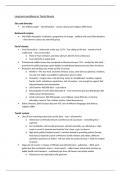Summary
Summary AQA A Level History Russia - Revolution and Dictatorship
- Course
- Institution
This is an in depth notes on the full course, including all the themes and facts covered by the A level course Revolution and Dictatorship: . Highly detailed yet very understandable. It goes through the course in time order, looking at events in depth and highlighting the themes/ topics they cover....
[Show more]



